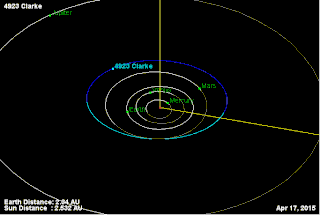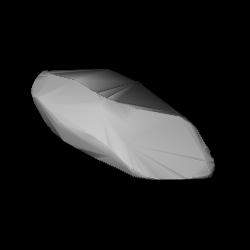Related Research Articles

4923 Clarke, provisional designation 1981 EO27, is a stony background asteroid from the inner regions of the asteroid belt, approximately 3.5 kilometers (2.2 miles) in diameter. It was discovered on 2 March 1981, by American astronomer Schelte Bus at the Siding Spring Observatory in Australia. The spheroidal S-type asteroid has a rotation period of 3.14 hours. It was named after British science fiction writer Arthur C. Clarke. On the same night, Schelte Bus also discovered 5020 Asimov.
1123 Shapleya, provisional designation 1928 ST, is a stony Florian asteroid from the inner regions of the asteroid belt, approximately 11 kilometers in diameter. It was discovered on 21 September 1928, by Russian astronomer Grigory Neujmin at Simeiz Observatory on the Crimean peninsula. It was named after American astronomer Harlow Shapley.
4899 Candace, provisional designation 1988 JU, is a background asteroid from the inner regions of the asteroid belt, approximately 7 kilometers in diameter. It was discovered on 9 May 1988, by astronomer couple Carolyn and Eugene Shoemaker at the Palomar Observatory in California, United States. The asteroid was named after American chemist Candace Kohl.

1652 Hergé, provisional designation 1953 PA, is a stony Florian asteroid from the inner regions of the asteroid belt, approximately 9 kilometers in diameter. It was discovered on 9 August 1953, by Belgian astronomer Sylvain Arend at the Royal Observatory of Belgium in Uccle, Belgium. It was later named after Belgian cartoonist Hergé.
3067 Akhmatova, provisional designation 1982 TE2, is a stony Flora asteroid from the inner regions of the asteroid belt, approximately 6 kilometers in diameter.
1717 Arlon, provisional designation 1954 AC, is a binary Florian asteroid from the inner regions of the asteroid belt, approximately 8.5 kilometers in diameter.
2033 Basilea, provisional designation 1973 CA, is a stony asteroid from the inner regions of the asteroid belt, approximately 6 kilometers in diameter. It was discovered on 6 February 1973, by astronomer Paul Wild at the Zimmerwald Observatory near Bern, Switzerland. The asteroid was named for the Swiss city of Basel.

1338 Duponta, provisional designation 1934 XA, is a stony Florian asteroid and synchronous binary system from the inner regions of the asteroid belt, approximately 7.8 kilometers in diameter.
1736 Floirac, provisional designation 1967 RA, is a stony Florian asteroid from the inner regions of the asteroid belt, approximately 8.7 kilometer in diameter.
1777 Gehrels, also designated 4007 P-L, is a stony asteroid from the middle region of the asteroid belt, approximately 13 kilometers in diameter. It was discovered during the Palomar–Leiden survey in 1960, and named for astronomer Tom Gehrels, one of the survey's principal investigators and credited discoverer.
5905 Johnson, provisional designation 1989 CJ1, is a Hungaria asteroid and synchronous binary system from the innermost regions of the asteroid belt, approximately 4 kilometers (2.5 miles) in diameter. It was discovered on 11 February 1989, by American astronomer Eleanor Helin at Palomar Observatory in California, United States. Its satellite measures approximately 1.6 km (1 mi) in diameter and orbits its primary every 21.8 hours. It was named after American astronomer and engineer Lindley N. Johnson.
5333 Kanaya, provisional designation 1990 UH, is a carbonaceous asteroid from the inner regions of the asteroid belt, approximately 14 kilometers in diameter.

1559 Kustaanheimo, provisional designation 1942 BF, is a stony asteroid from the inner regions of the asteroid belt, approximately 11 kilometers in diameter. It was discovered on 20 January 1942, by Finnish astronomer Liisi Oterma at the Iso-Heikkilä Observatory near Turku in southwest Finland. The asteroid was named after Finnish astronomer Paul Kustaanheimo (1924–1997).

2094 Magnitka (prov. designation: 1971 TC2) is a Flora asteroid from the inner regions of the asteroid belt, approximately 12 kilometers (7.5 miles) in diameter. It was discovered on 12 October 1971, at and by the Crimean Astrophysical Observatory in Nauchnyj, on the Crimean peninsula. The discovery has not been attributed to an observing astronomer. It was later named for the city of Magnitogorsk.
3066 McFadden, provisional designation 1984 EO, is a stony background asteroid from the central regions of the asteroid belt, approximately 15 kilometers in diameter. It was discovered on 1 March 1984, by American astronomer Edward Bowell at the Anderson Mesa Station near Tucson, Arizona. It was named for American planetary scientist Lucy-Ann McFadden. The assumed S-type asteroid has a rotation period of 13.8 hours.
1739 Meyermann, provisional designation 1939 PF, is a stony Florian asteroid from the inner regions of the asteroid belt, approximately 7.5 kilometers in diameter. It was discovered by German astronomer Karl Reinmuth at Heidelberg Observatory on 15 August 1939. It was later named in memory of astronomer Bruno Meyermann.
2815 Soma, provisional designation 1982 RL, is a binary Florian asteroid from the inner regions of the asteroid belt, approximately 7 kilometers in diameter. It was discovered on 15 September 1982, by American astronomer Edward Bowell at Lowell's Anderson Mesa Station in Flagstaff, Arizona, in the United States. It is named for the mechanical puzzle Soma cube.
2478 Tokai, provisionally designated 1981 JC, is a stony Florian asteroid and binary system from the inner regions of the asteroid belt, approximately 10 kilometers in diameter. It was discovered on 4 May 1981, by Japanese astronomer Toshimasa Furuta at Tōkai Observatory, Japan. The asteroid was named after the city of Tōkai.
1608 Muñoz, provisional designation 1951 RZ, is a Flora asteroid from the inner regions of the asteroid belt, approximately 6.5 kilometers in diameter. It was discovered on 1 September 1951, by Argentine astronomer Miguel Itzigsohn at the La Plata Astronomical Observatory, in La Plata, Argentina. The S-type asteroid has a rotation period of 5.3 hours. It was named after F. A. Muñoz, one of the assistant astronomers at the discovering observatory.
1530 Rantaseppä, provisional designation 1938 SG, is a stony Florian asteroid from the inner regions of the asteroid belt, approximately 5 kilometers in diameter. Discovered by Yrjö Väisälä at Turku Observatory in 1938, it was later named after Finnish astronomer Hilkka Rantaseppä-Helenius.
References
- 1 2 3 4 "JPL Small-Body Database Browser: 1806 Derice (1971 LC)" (2017-05-06 last obs.). Jet Propulsion Laboratory. Archived from the original on 18 September 2020. Retrieved 3 June 2017.
- 1 2 3 Schmadel, Lutz D. (2007). "(1806) Derice". Dictionary of Minor Planet Names – (1806) Derice. Springer Berlin Heidelberg. p. 145. doi:10.1007/978-3-540-29925-7_1807. ISBN 978-3-540-00238-3.
- 1 2 3 4 "LCDB Data for (1806) Derice". Asteroid Lightcurve Database (LCDB). Retrieved 16 May 2016.
- 1 2 3 Masiero, Joseph R.; Grav, T.; Mainzer, A. K.; Nugent, C. R.; Bauer, J. M.; Stevenson, R.; et al. (August 2014). "Main-belt Asteroids with WISE/NEOWISE: Near-infrared Albedos". The Astrophysical Journal. 791 (2): 11. arXiv: 1406.6645 . Bibcode:2014ApJ...791..121M. doi:10.1088/0004-637X/791/2/121 . Retrieved 8 December 2016.
- 1 2 3 4 Usui, Fumihiko; Kuroda, Daisuke; Müller, Thomas G.; Hasegawa, Sunao; Ishiguro, Masateru; Ootsubo, Takafumi; et al. (October 2011). "Asteroid Catalog Using Akari: AKARI/IRC Mid-Infrared Asteroid Survey". Publications of the Astronomical Society of Japan. 63 (5): 1117–1138. Bibcode:2011PASJ...63.1117U. doi:10.1093/pasj/63.5.1117. (online, AcuA catalog p. 153)
- 1 2 3 4 Mainzer, A.; Grav, T.; Masiero, J.; Hand, E.; Bauer, J.; Tholen, D.; et al. (November 2011). "NEOWISE Studies of Spectrophotometrically Classified Asteroids: Preliminary Results". The Astrophysical Journal. 741 (2): 25. arXiv: 1109.6407 . Bibcode:2011ApJ...741...90M. doi:10.1088/0004-637X/741/2/90 . Retrieved 16 May 2016.
- 1 2 3 4 Pravec, Petr; Harris, Alan W.; Kusnirák, Peter; Galád, Adrián; Hornoch, Kamil (September 2012). "Absolute magnitudes of asteroids and a revision of asteroid albedo estimates from WISE thermal observations". Icarus. 221 (1): 365–387. Bibcode:2012Icar..221..365P. doi:10.1016/j.icarus.2012.07.026 . Retrieved 4 November 2015.
- 1 2 Pray, Donald P.; Galad, Adrian; Husarik, Marek; Oey, Julian (March 2008). "Lightcurve Analysis of Fourteen Asteroids". The Minor Planet Bulletin. 35 (1): 34–36. Bibcode:2008MPBu...35...34P. ISSN 1052-8091 . Retrieved 4 November 2015.
- 1 2 Behrend, Raoul. "Asteroids and comets rotation curves – (1806) Derice". Geneva Observatory . Retrieved 16 May 2016.
- 1 2 "1806 Derice (1971 LC)". Minor Planet Center. Retrieved 16 May 2016.
- ↑ "MPC/MPO/MPS Archive". Minor Planet Center. Retrieved 16 May 2016.